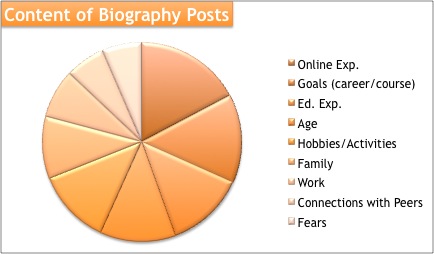Feminist Online Writing Courses
Civic Rhetoric, Community Action, and Student Success
Letizia Guglielmo
Community |
Biography |
Etiquette |
Questions |
Analysis: Biographies continued
Twenty-nine percent referenced (equally) work or career goals, while another 47.4 percent mentioned past educational experiences. Since I had asked students to comment on their experiences with online learning, I was not surprised to find that 63.2 percent did so, yet I was particularly interested to discover that 7.8 percent of respondents expressed fears or concerns about online learning environments; more surprising is that all of these respondents were enrolled in the same section of the course, suggesting perhaps that one students' admission allowed the others to express similar concerns. Just over thirteen percent of posts (13.2%) included mention of pets, and nearly half of the students (44.7%) mentioned extracurricular activities in which they were involved. Students also shared personal course goals (18.4%), additional contact information (specifically for MySpace and Facebook) (18.4%), and names or nicknames (including pronunciation and spelling) (18.4%).
Finally, in addition to the vulnerabilities that 23.7 percent of the study participants expressed regarding personal shortcomings, failures, weaknesses, and insecurities (expressed much more frequently in one section of the course than the other), an equal percentage attempted to make connections with the group in their initial posts; nearly sixteen percent of participants (15.8%) attempted to make connections with me by commenting on specific details included in my biography (New York, Auburn University/SEC football, Middle Tennessee State University, yoga, etc).
Because I was grounding the course in civic rhetoric with a decentered approach, I also wanted students to see me as part of the course community, and since I invited students to respond to as many biography posts as they wished, I assumed that students also would respond to my biography posting as a member of the course. I was surprised to find that I received no responses, yet upon further reflection, I wondered if this new decentered approach was atypical of what students had previously experienced in the classroom and if they believed that it was more appropriate to respond to the postings of their peers instead.
Of the thirty-eight participants, nine students responded to the postings of their peers, resulting in ten posts (one student responded to the posts of two peers). Again, it is important to mention that these response posts were not required and illustrate, instead, students’ desires to reach out to their peers. Since both sections of the course included a greater number of female students, it is not surprising that response posts by female students outnumbered those of male students by 8:2, yet in one section of the course, response posts were split equally between male and female participants.
